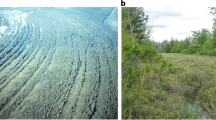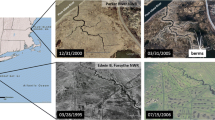Abstract
We studied a Great Lakes peatland protected by a barrier dune system to test the hypothesis that changes in the morphology of a barrier beach alter the wetland surface-water and ground-water hydrology such that the plant rooting zone in the wetland interior might be affected. Hydraulic head measured in observation wells located on transects perpendicular to a flow-through channel, uplands, and Lake Ontario were compared to lake-level changes, weather patterns, and the temporal conditions of the barrier beach. Water-table elevations within the wetland complex always remained 0.35 to 0.84 m above Lake Ontario's water level (mean difference = 0.62 m) and did not fluctuate in parallel with changes in the lake's water level. Flooding events occurred when breaches closed and isolated the wetland complex from Lake Ontario; daily average water levels rose between 0.06 m and 0.27 m. When the barrier beach was breached naturally or by human activity, daily average water-table elevations in the wetland receded between 0.16 m and 0.41 m. During the growing season, vertical ground-water-flow directions also changed as a function of changing hydraulies controlled by the barrier beach. Vertical recharge-discharge gradients ranged from −0.2 to 0.1 m·m−1. Water-table elevation and hydraulic head gradients across the study area were controlled primarily by short-term (days to weeks) changes in shoreline geomorphology, whereas seasonal weather patterns and Lake Ontario water-level fluctuations imposed secondary controls on the ground-water-flow regime.
Similar content being viewed by others
Literature cited
Bedford, B. L. 1996. The need to define hydrologic equivalence at the landscape scale for freshwater wetland mitigation. Ecological Applications 6:57–68.
Bedford, B. L.. 1999. Cumulative effects on wetland landscapes: links to wetland restoration in the United States and southern Canada. Wetlands 19:775–789.
Brunke, M. and T. Gonser. 1997. The ecological significance of exchange processes between rivers and ground-water. Freshwater Biology 37:1–33.
Chason, D. B. and D. I. Siegel. 1986. Hydraulic conductivity and related physical properties of peat. Lost River Peatland, Northern Minnesota. Soil Science 142:91–99.
Clausen, J. C. and G. D. Johnson. 1990. Lake level influences on sediment and nutrient retention in a lakeside wetlands. Journal of Environmental Quality 19:83–88.
DeGaetano, A. T., K. L. Eggleston, and W. W. Knapp. 1994. Northeast Regional Climate Center Daily Evapotranspiration and Soil Moisture Estimates for the Northeastern United States. Cornell University, Ithaca, NY, USA. Publication No. RR 94-1.
de Mars, H., M. J. Wassen, and H. G. M. Olde Venterink. 1997. Flooding and ground-water dynamics in fens in eastern Poland. Journal of Vegetation Science 8:319–328.
Doss, P. K.. 1993. The nature of a dynamic water table in a system of non-tidal, freshwater coastal wetlands. Journal of Hydrology 141:107–126.
Glaser, P. H., D. I. Siegel, E. A. Romanowicz, and Y. P. Shen. 1997. Regional linkages between raised bogs and the climate, groundwater, and landscape of north-western Minnesota. Journal of Ecology 8:3–16.
Health, R. T.. 1992. Nutrient dynamics in Great Lakes coastal wetlands: future directions. Journal of Great Lakes Research 18:90–602.
Keddy, P. A. and A. A. Reznicek. 1986. Great Lakes vegetation dynamics: the role of fluctuating water levels and buried seeds. Journal of Great Lakes Research 12:25–36.
Miller, T. S. 1982. Geology and ground-water resources of Oswego County, New York. U.S. Geological Survey, Water-Resources Investigations 81-60.
Mitsch, W. J. and B. C. Reeder. 1992. Nutrient and hydrologic budgets of a Great Lakes coastal freshwater wetland during a drought year. Wetlands Ecology and Management 1:211–222.
Mitsch, W. J., B. C. Reeder, and C. Carlson. 1989. Hydrology of a freshwater constal wetland during severe drought conditions. p. 69–79.In Wetlands of Ohio's Coastal Lake Erie—A hierarchy of Systems. Ohio Sea Grant College Program, Ohio State University, Columbus, OH, USA.
National Atmospheric Deposition Program (NRSP-3)/National Trends Network. 2002. NADP Program Office, Illinois State Water Survey. Champaign, IL, USA.
New York State Natural Heritage Program (NYSNHP). 1993. Deer Creek Marsh Wildlife Management Area: Biodiversity Inventory Final report, Latham, NY, USA.
Oswego County Soil and Water Conservation District (OC SWCD). 1996. Deer Creek Wildlife Management Area Elevation Survey Project Report. Oswego, NY, USA. Report # CWNY051396.
Rapparlie, D. F.. 1981. Soil survey of Oswego County, NY. U.S. Department of Agriculture—Soil Conservation Service. Washington, DC, USA.
Shedlock, R. J., D. A. Wilcox, T. A. Thompson, and D. Cohen. 1993. Interactions between ground-water and wetlands, southern shore of Lake Michigan, USA. Journal of Hydrology 141:127–155.
Smith, P. G. R., V. Glooschenko, and D. A. Hagen. 1991. Coastal wetlands of three Canadian Great Lakes: inventory, current conservation initiatives, and patterns of variation. Canadian Journal of Fisheries and Aquatic Sciences 48:1581–1594.
Siegel, D. I., A. Reeve, P. H. Glaser, and E. Romanowicz. 1995. Clinitate-driven flushing of pore water from humified peat: geochemical and ecological ramifications. Nature 15:493–500.
Sutton, R. G., T. L. Lewis, and D. L. Woodrow. 1972. Post-Iroquois lake stages and shoreline sedimentation in Eastern Ontario basin. Journal of Geology 80:346–356.
U.S. Army Corps of Engineers. 1997a. Monthly Bulletin of Lake Levels for the Great Lakes—Great Lakes Update. North Central Division, Detroit, MI, USA, June 5, 1997.
U.S. Army Corps of Engineers. 1997b. (http://hank.ncb.usace.army.mil/GreatLakes).
van der Valk, A. G., L. Squires, and C. H. Welling. 1994. Assessing the impacts of an increase in water level on wetland vegetation. Ecological Applications 4:525–534.
Waller, R. M. and W. B. Allen. 1975. Appendix 3: Geology and Ground-water—Great Lakes Basin Framework Study. Public Information Office, Great Lakes Basin Commission, Ann Arbor, MI, USA.
Wassen, M. J., A. Barendregt, A. Palczynski, J. T. D. Smidt, and H. de Mars. 1990. The relationship between fen vegetation gradients, ground-water flow and flooding in an undrained valley mire at Biebrza, Poland. Journal of Ecology 78:1106–1122.
Wilcox, D. A., R. J. Shedlock, and W. H. Henderson. 1986. Hydrology, water chemistry and ecological relations in the raised mound of Cowles Bog. Journal of Ecology 74:1103–1117.
Wilcox, D. A., J. E. Meeker, and J. Elias. 1993. Impacts of Water Level Regulation on Wetlands of the Great Lakes. U.S. Fish and Wildlife Service National Fisheries Research Center—Great Lakes, Ann Arbor, MI, USA.
Winter, T. C. and D. O. Rosenberry. 1995. The interaction of ground water with prairie pothole wetlands in the Cottonwood Lake area, east-central North Dakota, 1979–1990. Wetlands 15:193–211.
Winter, T. C.. 1999. Relation of streams, lakes, and wetlands to ground-water flow systems. Hydrogeology Journal 7:28–45.
Woodrow, D. L. and C. E. McClennan. 2002. Eastern Lake Ontario Sand Transport Study: Final Report on Sediment Transport Patterns and Management Implications for Eastern Lake Ontario. The Nature Conservancy. Rochester, NY, USA.
Author information
Authors and Affiliations
Rights and permissions
About this article
Cite this article
Bailey, K.M., Bedford, B.L. Transient geomorphic control of water table and hydraulic head reversals in a coastal freshwater peatland. Wetlands 23, 969–978 (2003). https://doi.org/10.1672/0277-5212(2003)023[0969:TGCOWT]2.0.CO;2
Received:
Revised:
Accepted:
Issue Date:
DOI: https://doi.org/10.1672/0277-5212(2003)023[0969:TGCOWT]2.0.CO;2




